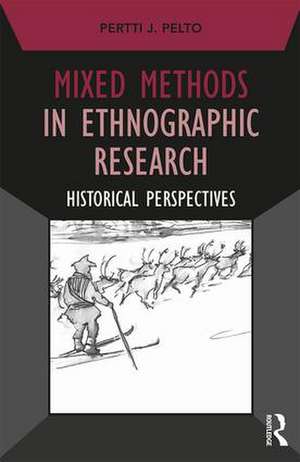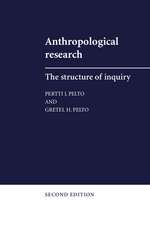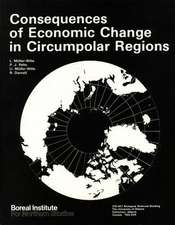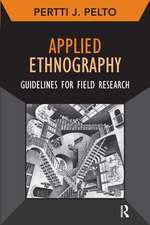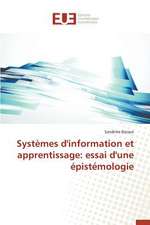Mixed Methods in Ethnographic Research: Historical Perspectives: Developing Qualitative Inquiry
Autor Pertti J. Peltoen Limba Engleză Paperback – 3 mar 2017
| Toate formatele și edițiile | Preț | Express |
|---|---|---|
| Paperback (1) | 418.13 lei 43-57 zile | |
| Taylor & Francis – 3 mar 2017 | 418.13 lei 43-57 zile | |
| Hardback (1) | 878.42 lei 43-57 zile | |
| Taylor & Francis – 6 mar 2017 | 878.42 lei 43-57 zile |
Din seria Developing Qualitative Inquiry
-
 Preț: 294.82 lei
Preț: 294.82 lei -
 Preț: 288.34 lei
Preț: 288.34 lei -
 Preț: 341.33 lei
Preț: 341.33 lei -
 Preț: 295.16 lei
Preț: 295.16 lei -
 Preț: 314.86 lei
Preț: 314.86 lei -
 Preț: 342.05 lei
Preț: 342.05 lei - 8%
 Preț: 389.24 lei
Preț: 389.24 lei -
 Preț: 356.64 lei
Preț: 356.64 lei -
 Preț: 279.12 lei
Preț: 279.12 lei -
 Preț: 372.26 lei
Preț: 372.26 lei -
 Preț: 392.28 lei
Preț: 392.28 lei -
 Preț: 392.60 lei
Preț: 392.60 lei -
 Preț: 384.59 lei
Preț: 384.59 lei -
 Preț: 368.41 lei
Preț: 368.41 lei -
 Preț: 367.49 lei
Preț: 367.49 lei -
 Preț: 258.20 lei
Preț: 258.20 lei - 28%
 Preț: 638.09 lei
Preț: 638.09 lei -
 Preț: 361.25 lei
Preț: 361.25 lei -
 Preț: 352.63 lei
Preț: 352.63 lei -
 Preț: 348.87 lei
Preț: 348.87 lei -
 Preț: 353.57 lei
Preț: 353.57 lei - 18%
 Preț: 1175.33 lei
Preț: 1175.33 lei - 19%
 Preț: 549.94 lei
Preț: 549.94 lei
Preț: 418.13 lei
Nou
Puncte Express: 627
Preț estimativ în valută:
80.03€ • 86.96$ • 67.27£
80.03€ • 86.96$ • 67.27£
Carte tipărită la comandă
Livrare economică 21 aprilie-05 mai
Preluare comenzi: 021 569.72.76
Specificații
ISBN-13: 9781629582078
ISBN-10: 1629582077
Pagini: 356
Ilustrații: 24 Halftones, black and white; 2 Tables, black and white; 24 Illustrations, black and white
Dimensiuni: 152 x 229 x 20 mm
Greutate: 0.5 kg
Ediția:1Text mare
Editura: Taylor & Francis
Colecția Routledge
Seria Developing Qualitative Inquiry
Locul publicării:Oxford, United Kingdom
ISBN-10: 1629582077
Pagini: 356
Ilustrații: 24 Halftones, black and white; 2 Tables, black and white; 24 Illustrations, black and white
Dimensiuni: 152 x 229 x 20 mm
Greutate: 0.5 kg
Ediția:1Text mare
Editura: Taylor & Francis
Colecția Routledge
Seria Developing Qualitative Inquiry
Locul publicării:Oxford, United Kingdom
Cuprins
CONTENTS
Preface
Chapter 1. Mixed Methods Research in Ethnography, Qualitative and Quantitative
Ethnography in Earlier Times
Al Biruni
Bernadino de Sahagun (1499-1590)
Applied Ethnographic Field Work, Cultural Patterns, and Research Methods
Applied Field Research: Many Disciplines, Many Players
The Different Histories of Quantitative and Qualitative Research in Applied Field Research and Academic Research
Disillusionment with Quantitative Surveys
The New Interest in "Mixed Methods" in the Social Sciences
Chapter 2. Mixed Methods in 19th Century Ethnography
J. Sjogren, Finnish Linguist-Ethnographer
Mathias A. Castren
Other 19th Century Finnish Ethnographer-Linguists
Vladimir Bogoraz, Russian Ethnographer/Linguist/Revolutionary
Franz Boas: Promoter of Mixed Methods in North America
Chapter 3. The Developing Discourse of Mixed Method Research
The QUAL versus QUAN Paradigm Debates
Many Problems in the Current Mixed Methods "Paradigm Concepts"
How Did Qualitative Data-Gathering Gain Acceptance in Quantitative-Dominated Research Areas?
A New Wave of Mixed Methods
QUAN+qual, QUAL à quan; Let’s Get on with the Fun
More Complex, Multiple Methods Mixtures (MMM)
QUAL+quan and QUAL à quan designs are very common
The Traditions of Publishing Make a Big Difference for Mixing of Methods
Summary and Conclusions
Chapter 4. Culture and Personality Studies: Plenty of Mixed Methods
Life in a Mexican Village; A Study by Oscar Lewis and Associates
Personality Formation among the Navaho People
Acculturation and Culture/Personality Studies
The "Newer" Culture and Personality Studies
Acculturation, Self-Identification and Personality Adjustment in an Inuit Village
Analysis of the Data
Farmers and Herdsmen in East Africa: Effects of Ecological Factors on Values, Attitudes, and Psychological Characteristics
Quantitative Scale from "Full-Scale Farming to Full-Scale Herding"
Discussion and Conclusions
Chapter 5. Large Multi-Year, Multi-Site, Multi-Disciplinary Research Projects
The Hawthorne Study: Mixed Methods in an Early Applied Project
Yankee City Series: Volume IV. "The Strike: A Social Analysis"
The Big Strike
The Great Mix of Methods: Qualitative and Quantitative
The Ethnic Groups in Yankee City
"Yankee City" in Historical Perspective: Criticisms and Credits
"Public Health as a Career in Medicine:" Another Large-Scale Study
Phase Two
Summary and Conclusions
Chapter 6. Ecosystems Theory, Adaptation, and New Directions in Research
An Early Applied Study of Up-grading Navaho Economy and Health
Massive Environmental Change: Ecosystem Effects of a Dam Project
Commentary
Pigs for the Ancestors: A Focus on Ritual as Ecological Regulator
Quantitative Data
Qualitative Data: Ethnography of Ritual
Discussion and Criticism Sparked by Pigs for the Ancestors
Structural Change in Northern Thai Rice Villages
Sarmela’s English Language Summary
Focus on Agricultural Adaptations in Rural Mexico
Discussion and Conclusions
Chapter 7. Medical Anthropology and Mixed Methods Research
Another Epidemic: Diphtheria Immunization in Thailand
Sorcery and Medicine in the Philippines
The Sociology of an Indian Hospital Ward
The Complex Varieties of Academic and Applied Medical Anthropology
Biological and Cultural Adaptations: The Ecological Framework
Anthropology and Mental Health: Psychosis in East Africa
Long-Term Multidisciplinary Research in Selected Study Populations
Multiple Research Methods in Complex Ethnography: West Africa
An Unusual Category: Combining Ethnography and Quantitative Experiment
Intervention: Development and Testing of a Model MCE Program
Conclusion
Chapter 8. QUAL+qual and QUAL à qual Studies: Common Practices in Ethnography
Coming of Age in Samoa 1928: Margaret Mead’s Seminal Study
A Famous QUAL+QUALà qual Study: Street Corner Society
Getting Started, Learning Field Research
Components of the Research Methods
"Doc," the Most Famous "Key Informant" in Field Research Literature
Sub-Project: Mapping the Social Interactions at the Club
Other Examples of Mixed Methods in QUAL Research. Mixed Methods in Linguistic Research
QUALà qual Triangulation
James P. Spradley: "Grand Tour Interviews" and Other Special Methods
Extensive Participation: Sometimes It Is A "Supplemental Method"
Concluding Comments
Chapter 9. The Development of Quantitative Methods in Ethnographic Research
British Ethnographers Started Doing Surveys Early in the 20th Century
An "Experiment" with Survey Research Methods in Africa
More Specialized Survey Research "Experiments"
Small-Scale Surveys: Other Variations on the Survey Model(s)
A Different Kind of Mixed Method Research: Cultural Analysis of P-3 Pilot Error
The Study of High Concordance Domains
High versus Low Concordance Domains, and Sampling
"Tight" and "Loose" Societies
Cultural Consensus and Sample Sizes
Cultural Data, Key Informants, and Concordance
Summary and Conclusions
Chapter 10. Food, Diet and Nutrition Studies
Studies of Food Distribution and Dietary Behaviors
Diet and Hunger in Northern Rhodesia
Hunger Months
The Monograph as a Classic Mixed Methods Study of Food and Nutrition
Diet in the Mexican Town of Tepoztlan
A Diet and Nutrition Intervention in South Africa
Nutritional Anthropology: Interdisciplinary Mixed Methods Research
New Achievements in Mixed Methods Diet and Nutrition Studies
The Role of Fruits and Wild Greens in the Shambaa Diet in Tanzania
A Study of Malnutrition in Mali
Research on Vitamin A Deficiency: A Multi-Site, Interdisciplinary Study
Hypothetical Scenarios for Getting Data on Night-Blindness and Other Symptoms
Multi-Year, Multi-Disciplinary Mixed-Methods Study in Central Mexico
Major Finding: "Small is Not Healthy and Happy"
Summary and Conclusions
Chapter 11. The Rise of Community Studies and Ecological Theory: Paradigm Transitions in Finland
Hilma N. Granqvist: Ethnographic Study of a Palestinian Village, 1925-1931
Research in Lapland: Kalle Nickul’s "Discover" of the Skolt Saami Community
Mapping and Other Mixed Methods Research in Suenjel (Kola Peninsula)
Kai Donner: Another "Early Modern" Contributor to Paradigm Change
Community Studies and Ecological Frameworks: Later Trends in the 20th Century
Adaptive Strategies in the Aland Islands
Community Studies and Ecological Theory in More Recent Finnish Ethnographic Research
Concluding Discussion
Chapter 12. My Explorations in QUAL+quan Research Methodology
Doctoral Dissertation Research in Finnish Lapland
The Upper Mississippi Research Project
Thinking about Research Methods
Thinking about Different Kinds of Societies
The Snowmobile Revolution: Technology and Social Change
Technology and De-localization
Notes on Methodology
Varieties of Delocalization: Food and Diet
Conclusions: More Recent Developments
Chapter 13. Triangulation and Descriptive Expansion: The Uses of Mixed Methods in Ethnographic Research
Exploring "Descriptive Expansion" and Related Purposes of Mixed Methods Designs
Understanding the Concept of Triangulation in Mixed-Methods Research
Broader Definitions of "Triangulation"
Triangulation Studies for Assessing Informant Accuracy
Key Informant Reliability: Another Look at Interview Data
Triangulation and Informant Precision
Comparing Individual In-Depth Interviews and Group Discussion Methods
Triangulation and Mixed-Methods Research in Action
Triangulation with Multiple Quantified Data Gathering Methods: Alaska
Triangulation at the Level of Theory and Data Analysis
Informal Triangulation in Ethnographic Field Research
A Loose Use of the Triangulation Concept in Ethnographic Research
Triangulation in Qualitative Ethnographic Research: A Case of "Investigator Triangulation"
Triangulation is Only One of Several Mixed-Methods Research Categories
Criticisms and Critiques of Triangulation in the Social Sciences
Summary and Conclusions
The Basic Lesson
Chapter 14. Two Decades of Mixed-Methods in South Asia
The Technical Assistance Program: "Building Social Science Capacity for Research on Women’s Health in India"
QUAL-QUAN Mixed-Method Research Tools
Mixing Qualitative and Quantitative Data Was Already Common in South Asia
Developing a Manual for Field Training and Guidelines for Data-Gathering and Analysis
Other Developments in the Mid-1990s
Implementing a Reproductive Health Agenda in India: The Beginning
Reproductive Health in India: New Evidence
Ethnographic Field Research in South Asia
Women’s Perceptions of White Vaginal Discharge: Ethnographic Data from Rural Maharashtra
Evaluation of a Rural Community Health Program
Women’s Work and Child Health
Ethnographic Study of Sex Workers in a Red Light District in Kolkata
Examples of Mixed Methods Research in Bangladesh
The HIV/AIDs Pandemic and Mixed Methods Research
HIV/AIDs and the 21st Century in South Asia: Our Book of Research Results
Examples of Research on Sexual Behavior during the Technical Assistance Program
Other Noteworthy Studies in this Collection
Men’s Sexual Health Concerns in Mumbai
Women’s Reproductive Health in the Time of AIDs
Continued Research in Issues around Pregnancy, Childbirth, Abortion, and other Reproductive Health Matters
Summary: Mixed Methods Research in South Asia
Chapter 15. Two "Histories" of Mixed Methods Research
Mixed Methods in Ethnographic Research: Early Times
New Pathways to Mixed Methods in the 20th Century
Multi-Disciplinary and Large-Scale Projects Often Led to Mixed Methods
Inter-Disciplinary Research Teams: A Different Pathway to MM
Mixed Methods in Health Research
Ethnographic Publications are often in Books or Large Printed Reports
Quantitative Research Approaches Have Often Been Inductive
The "Other History" of Mixed Methods and the Recent Spread of Interest in Qualitative Ethnographic Research
New Explorations in Qualitative Research Methods, Especially in Developing Country Programs
Participatory Rural Appraisal (PRA) and Rapid Rural Appraisal (RR)
Focused Ethnographic Studies (FES)
Other Influences Favoring Qualitative Data Approaches and Mixed Methods
Influences from the Computer Revolution
The Big Picture: Mixed Methods Approaches Are Essential Because Each Individual Method Has Weaknesses. But There Is More: There Are Multiple Sectors of Data in the Real World
Preface
Chapter 1. Mixed Methods Research in Ethnography, Qualitative and Quantitative
Ethnography in Earlier Times
Al Biruni
Bernadino de Sahagun (1499-1590)
Applied Ethnographic Field Work, Cultural Patterns, and Research Methods
Applied Field Research: Many Disciplines, Many Players
The Different Histories of Quantitative and Qualitative Research in Applied Field Research and Academic Research
Disillusionment with Quantitative Surveys
The New Interest in "Mixed Methods" in the Social Sciences
Chapter 2. Mixed Methods in 19th Century Ethnography
J. Sjogren, Finnish Linguist-Ethnographer
Mathias A. Castren
Other 19th Century Finnish Ethnographer-Linguists
Vladimir Bogoraz, Russian Ethnographer/Linguist/Revolutionary
Franz Boas: Promoter of Mixed Methods in North America
Chapter 3. The Developing Discourse of Mixed Method Research
The QUAL versus QUAN Paradigm Debates
Many Problems in the Current Mixed Methods "Paradigm Concepts"
How Did Qualitative Data-Gathering Gain Acceptance in Quantitative-Dominated Research Areas?
A New Wave of Mixed Methods
QUAN+qual, QUAL à quan; Let’s Get on with the Fun
More Complex, Multiple Methods Mixtures (MMM)
QUAL+quan and QUAL à quan designs are very common
The Traditions of Publishing Make a Big Difference for Mixing of Methods
Summary and Conclusions
Chapter 4. Culture and Personality Studies: Plenty of Mixed Methods
Life in a Mexican Village; A Study by Oscar Lewis and Associates
Personality Formation among the Navaho People
Acculturation and Culture/Personality Studies
The "Newer" Culture and Personality Studies
Acculturation, Self-Identification and Personality Adjustment in an Inuit Village
Analysis of the Data
Farmers and Herdsmen in East Africa: Effects of Ecological Factors on Values, Attitudes, and Psychological Characteristics
Quantitative Scale from "Full-Scale Farming to Full-Scale Herding"
Discussion and Conclusions
Chapter 5. Large Multi-Year, Multi-Site, Multi-Disciplinary Research Projects
The Hawthorne Study: Mixed Methods in an Early Applied Project
Yankee City Series: Volume IV. "The Strike: A Social Analysis"
The Big Strike
The Great Mix of Methods: Qualitative and Quantitative
The Ethnic Groups in Yankee City
"Yankee City" in Historical Perspective: Criticisms and Credits
"Public Health as a Career in Medicine:" Another Large-Scale Study
Phase Two
Summary and Conclusions
Chapter 6. Ecosystems Theory, Adaptation, and New Directions in Research
An Early Applied Study of Up-grading Navaho Economy and Health
Massive Environmental Change: Ecosystem Effects of a Dam Project
Commentary
Pigs for the Ancestors: A Focus on Ritual as Ecological Regulator
Quantitative Data
Qualitative Data: Ethnography of Ritual
Discussion and Criticism Sparked by Pigs for the Ancestors
Structural Change in Northern Thai Rice Villages
Sarmela’s English Language Summary
Focus on Agricultural Adaptations in Rural Mexico
Discussion and Conclusions
Chapter 7. Medical Anthropology and Mixed Methods Research
Another Epidemic: Diphtheria Immunization in Thailand
Sorcery and Medicine in the Philippines
The Sociology of an Indian Hospital Ward
The Complex Varieties of Academic and Applied Medical Anthropology
Biological and Cultural Adaptations: The Ecological Framework
Anthropology and Mental Health: Psychosis in East Africa
Long-Term Multidisciplinary Research in Selected Study Populations
Multiple Research Methods in Complex Ethnography: West Africa
An Unusual Category: Combining Ethnography and Quantitative Experiment
Intervention: Development and Testing of a Model MCE Program
Conclusion
Chapter 8. QUAL+qual and QUAL à qual Studies: Common Practices in Ethnography
Coming of Age in Samoa 1928: Margaret Mead’s Seminal Study
A Famous QUAL+QUALà qual Study: Street Corner Society
Getting Started, Learning Field Research
Components of the Research Methods
"Doc," the Most Famous "Key Informant" in Field Research Literature
Sub-Project: Mapping the Social Interactions at the Club
Other Examples of Mixed Methods in QUAL Research. Mixed Methods in Linguistic Research
QUALà qual Triangulation
James P. Spradley: "Grand Tour Interviews" and Other Special Methods
Extensive Participation: Sometimes It Is A "Supplemental Method"
Concluding Comments
Chapter 9. The Development of Quantitative Methods in Ethnographic Research
British Ethnographers Started Doing Surveys Early in the 20th Century
An "Experiment" with Survey Research Methods in Africa
More Specialized Survey Research "Experiments"
Small-Scale Surveys: Other Variations on the Survey Model(s)
A Different Kind of Mixed Method Research: Cultural Analysis of P-3 Pilot Error
The Study of High Concordance Domains
High versus Low Concordance Domains, and Sampling
"Tight" and "Loose" Societies
Cultural Consensus and Sample Sizes
Cultural Data, Key Informants, and Concordance
Summary and Conclusions
Chapter 10. Food, Diet and Nutrition Studies
Studies of Food Distribution and Dietary Behaviors
Diet and Hunger in Northern Rhodesia
Hunger Months
The Monograph as a Classic Mixed Methods Study of Food and Nutrition
Diet in the Mexican Town of Tepoztlan
A Diet and Nutrition Intervention in South Africa
Nutritional Anthropology: Interdisciplinary Mixed Methods Research
New Achievements in Mixed Methods Diet and Nutrition Studies
The Role of Fruits and Wild Greens in the Shambaa Diet in Tanzania
A Study of Malnutrition in Mali
Research on Vitamin A Deficiency: A Multi-Site, Interdisciplinary Study
Hypothetical Scenarios for Getting Data on Night-Blindness and Other Symptoms
Multi-Year, Multi-Disciplinary Mixed-Methods Study in Central Mexico
Major Finding: "Small is Not Healthy and Happy"
Summary and Conclusions
Chapter 11. The Rise of Community Studies and Ecological Theory: Paradigm Transitions in Finland
Hilma N. Granqvist: Ethnographic Study of a Palestinian Village, 1925-1931
Research in Lapland: Kalle Nickul’s "Discover" of the Skolt Saami Community
Mapping and Other Mixed Methods Research in Suenjel (Kola Peninsula)
Kai Donner: Another "Early Modern" Contributor to Paradigm Change
Community Studies and Ecological Frameworks: Later Trends in the 20th Century
Adaptive Strategies in the Aland Islands
Community Studies and Ecological Theory in More Recent Finnish Ethnographic Research
Concluding Discussion
Chapter 12. My Explorations in QUAL+quan Research Methodology
Doctoral Dissertation Research in Finnish Lapland
The Upper Mississippi Research Project
Thinking about Research Methods
Thinking about Different Kinds of Societies
The Snowmobile Revolution: Technology and Social Change
Technology and De-localization
Notes on Methodology
Varieties of Delocalization: Food and Diet
Conclusions: More Recent Developments
Chapter 13. Triangulation and Descriptive Expansion: The Uses of Mixed Methods in Ethnographic Research
Exploring "Descriptive Expansion" and Related Purposes of Mixed Methods Designs
Understanding the Concept of Triangulation in Mixed-Methods Research
Broader Definitions of "Triangulation"
Triangulation Studies for Assessing Informant Accuracy
Key Informant Reliability: Another Look at Interview Data
Triangulation and Informant Precision
Comparing Individual In-Depth Interviews and Group Discussion Methods
Triangulation and Mixed-Methods Research in Action
Triangulation with Multiple Quantified Data Gathering Methods: Alaska
Triangulation at the Level of Theory and Data Analysis
Informal Triangulation in Ethnographic Field Research
A Loose Use of the Triangulation Concept in Ethnographic Research
Triangulation in Qualitative Ethnographic Research: A Case of "Investigator Triangulation"
Triangulation is Only One of Several Mixed-Methods Research Categories
Criticisms and Critiques of Triangulation in the Social Sciences
Summary and Conclusions
The Basic Lesson
Chapter 14. Two Decades of Mixed-Methods in South Asia
The Technical Assistance Program: "Building Social Science Capacity for Research on Women’s Health in India"
QUAL-QUAN Mixed-Method Research Tools
Mixing Qualitative and Quantitative Data Was Already Common in South Asia
Developing a Manual for Field Training and Guidelines for Data-Gathering and Analysis
Other Developments in the Mid-1990s
Implementing a Reproductive Health Agenda in India: The Beginning
Reproductive Health in India: New Evidence
Ethnographic Field Research in South Asia
Women’s Perceptions of White Vaginal Discharge: Ethnographic Data from Rural Maharashtra
Evaluation of a Rural Community Health Program
Women’s Work and Child Health
Ethnographic Study of Sex Workers in a Red Light District in Kolkata
Examples of Mixed Methods Research in Bangladesh
The HIV/AIDs Pandemic and Mixed Methods Research
HIV/AIDs and the 21st Century in South Asia: Our Book of Research Results
Examples of Research on Sexual Behavior during the Technical Assistance Program
Other Noteworthy Studies in this Collection
Men’s Sexual Health Concerns in Mumbai
Women’s Reproductive Health in the Time of AIDs
Continued Research in Issues around Pregnancy, Childbirth, Abortion, and other Reproductive Health Matters
Summary: Mixed Methods Research in South Asia
Chapter 15. Two "Histories" of Mixed Methods Research
Mixed Methods in Ethnographic Research: Early Times
New Pathways to Mixed Methods in the 20th Century
Multi-Disciplinary and Large-Scale Projects Often Led to Mixed Methods
Inter-Disciplinary Research Teams: A Different Pathway to MM
Mixed Methods in Health Research
Ethnographic Publications are often in Books or Large Printed Reports
Quantitative Research Approaches Have Often Been Inductive
The "Other History" of Mixed Methods and the Recent Spread of Interest in Qualitative Ethnographic Research
New Explorations in Qualitative Research Methods, Especially in Developing Country Programs
Participatory Rural Appraisal (PRA) and Rapid Rural Appraisal (RR)
Focused Ethnographic Studies (FES)
Other Influences Favoring Qualitative Data Approaches and Mixed Methods
Influences from the Computer Revolution
The Big Picture: Mixed Methods Approaches Are Essential Because Each Individual Method Has Weaknesses. But There Is More: There Are Multiple Sectors of Data in the Real World
Notă biografică
Pertti J. (Bert) Pelto, Ph.D., is Professor Emeritus of Anthropology at the University of Connecticut, where he played a major role in developing the program in applied medical anthropology. He has also served as a consultant for many international health organizations, providing training in mixed methods ethnographic research for community-based applied projects. Best known for his groundbreaking book on research methods (Anthropological Research: The Structure of Inquiry, 1970), Professor Pelto was recently (2016) honored by the Society for Applied Anthropology with the establishment of the biennial "Pertti Pelto International Travel Award," in recognition of his contributions to training in applied field research methods in international contexts.
Recenzii
Prime architect of the methodology of employing mixed methods in ethnographic research, Pertti J Pelto, traces it's historical evolution globally. His personal narrative provides practical, experiential learnings for obtaining nuanced answers to complex research questions. Through decades of work with research networks and communities in India and other developing countries, Pelto succeeded in legitimizing the once suspect qualitative techniques. It is because of his untiring efforts that integrating qualitative with quantitative methods has become the norm today.
Saroj Pachauri, MD, PhD, DPH, Distinguished Scholar, Population Council
Only Pertti Pelto could have written this history –a tour de force of erudition. The book makes clear that anthropology is and has always been about mixed methods, but social scientists of all stripes will find wonderful material here for teaching mixed methods.
H. Russell Bernard, Professor Emeritus of Anthropology, University of Florida; Director of the Institute for Social Science Research, Arizona State University
In his latest book, Pertti Pelto takes us on a captivating, personal and historical tour of the use of mixed methods in social science research. His narrative style and stories from the from the field make this both a fun read and an important reference for students and researchers who want to gain a broader understanding of past and present developments in ethnographic research methods.
Patricia Hudelson, PhD, Anthropologue médicale, Consultation transculturelle et interprétariat, Département de médecine communautaire, de premier recours et des urgences, Hôpitaux Universitaires de Genève
In this immensely insightful, rich and readable ‘story’ of ethnographic research in the use of mixed methods, Professor Pelto reminds us how important is the historical perspective concerning research methods and strategies. In the absence of this clarity, social scientists and public health researchers are likely to polarize the discourse of qualitative versus quantitative methods and fail to take cognizance of various nuanced ways in which multi-method approaches enhance our knowledge creation. I can hardly overemphasize the timeliness of this book
Ravi Verma, PhD, Regional Director, Asia, International Center for Research on Women
Mixed Methods Research captures a wide and throughout picture of ethnographical research methods. It brings interestingly together the historical development and Pelto’s personal reflections on interaction of qualitative and quantitative research methods. Pelto’s wide experience of ethnographical research makes this book is an enjoyable reading and important guide for students as well as professional scholars all over the world. This book answers to a growing need for a practical guide in data-gathering.
Inker-Anni Linkola, Senior Officer, Sámi Archives, Sajos
Even in constructing his comprehensive and complex work on the application of mixed metholodologies, Pertti J. Pelto is a lively and engaging academic narrator, who succeeds to interpret deep issues and problems which have occupied generations of anthropologists. He weaves into the discussion his intensive long-term personal knowledge and experiences in multiple disciplines in various cultural settings, from the Skolt Sami in northernmost Europe to rural communities in South Asia. Pelto provides researchers and other actors, such as non-governmental organizations, with insights, strategies, and tools to apply mixed methodologies to health and social issues or economic and ecological understanding in an easily accessible manner."
Veli-Pekka Lehtola, Professor for Sámi cultural studies, Giellagas Institute, University of Oulu
Saroj Pachauri, MD, PhD, DPH, Distinguished Scholar, Population Council
Only Pertti Pelto could have written this history –a tour de force of erudition. The book makes clear that anthropology is and has always been about mixed methods, but social scientists of all stripes will find wonderful material here for teaching mixed methods.
H. Russell Bernard, Professor Emeritus of Anthropology, University of Florida; Director of the Institute for Social Science Research, Arizona State University
In his latest book, Pertti Pelto takes us on a captivating, personal and historical tour of the use of mixed methods in social science research. His narrative style and stories from the from the field make this both a fun read and an important reference for students and researchers who want to gain a broader understanding of past and present developments in ethnographic research methods.
Patricia Hudelson, PhD, Anthropologue médicale, Consultation transculturelle et interprétariat, Département de médecine communautaire, de premier recours et des urgences, Hôpitaux Universitaires de Genève
In this immensely insightful, rich and readable ‘story’ of ethnographic research in the use of mixed methods, Professor Pelto reminds us how important is the historical perspective concerning research methods and strategies. In the absence of this clarity, social scientists and public health researchers are likely to polarize the discourse of qualitative versus quantitative methods and fail to take cognizance of various nuanced ways in which multi-method approaches enhance our knowledge creation. I can hardly overemphasize the timeliness of this book
Ravi Verma, PhD, Regional Director, Asia, International Center for Research on Women
Mixed Methods Research captures a wide and throughout picture of ethnographical research methods. It brings interestingly together the historical development and Pelto’s personal reflections on interaction of qualitative and quantitative research methods. Pelto’s wide experience of ethnographical research makes this book is an enjoyable reading and important guide for students as well as professional scholars all over the world. This book answers to a growing need for a practical guide in data-gathering.
Inker-Anni Linkola, Senior Officer, Sámi Archives, Sajos
Even in constructing his comprehensive and complex work on the application of mixed metholodologies, Pertti J. Pelto is a lively and engaging academic narrator, who succeeds to interpret deep issues and problems which have occupied generations of anthropologists. He weaves into the discussion his intensive long-term personal knowledge and experiences in multiple disciplines in various cultural settings, from the Skolt Sami in northernmost Europe to rural communities in South Asia. Pelto provides researchers and other actors, such as non-governmental organizations, with insights, strategies, and tools to apply mixed methodologies to health and social issues or economic and ecological understanding in an easily accessible manner."
Veli-Pekka Lehtola, Professor for Sámi cultural studies, Giellagas Institute, University of Oulu
Descriere
Mixed Methods Research: A Personal History captures the dynamic history and development of mixed methods research in a narrative of personal discovery, growth, and experience.
